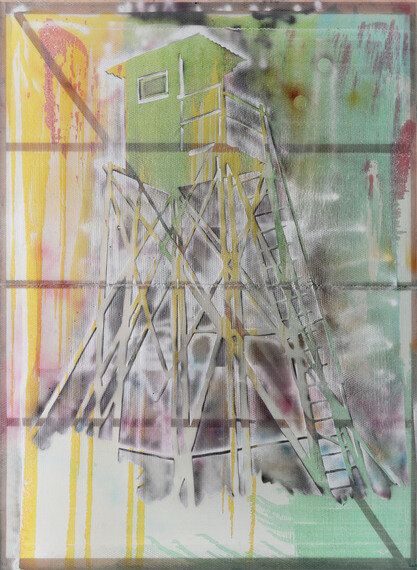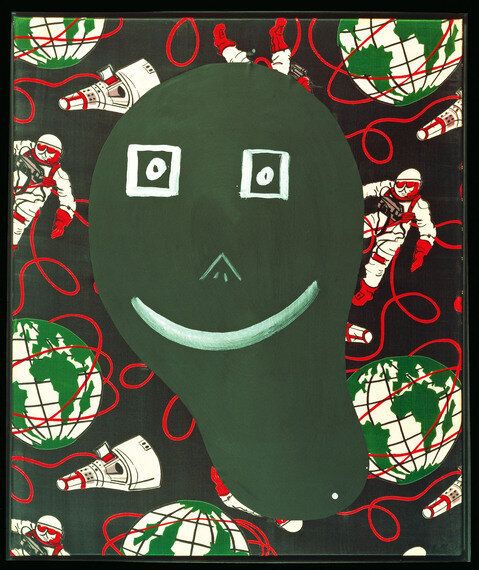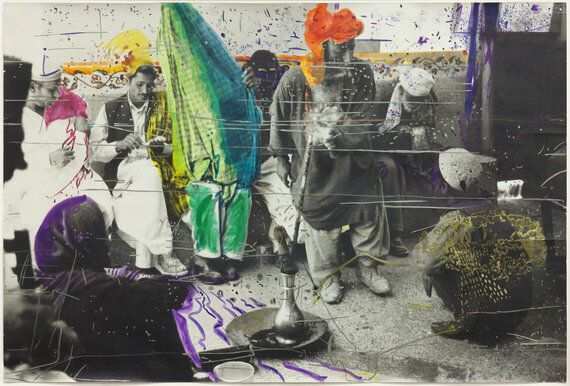
Sigmar Polke was one of the most radical, experimental and influential artists of the past 50 years. And the Tate has brought together an extraordinary and vast collection of Polke's works for this comprehensive retrospective.
Polke had a problem with orthodoxy. He hated it and throughout his career he sought to challenge and overturn expectations about art and artists. He was particularly sceptical about authoritarian ideas of looking at and understanding images.
I say this first, because it's true but second, because this is crucial in getting a grasp on the sprawling variety of media and form throughout Polke's works. Drawings, paintings, objects, film... Polke investigated and used all forms in his work. And nor did he stick to the more usual media of paper and paints. As this exhibition demonstrates, Polke used materials as varied as meteor dust, potatoes, soot, Native American arrow heads and vivid pink faux-fur throws in his work, and he would paint on bubble-wrap, glass, wallpaper and his kids' pyjamas as much as paper and canvas.
Polke was determined to bring art away from the clasps of the elite and into the everyday world hence nothing was considered inappropriate for use in his work.
Born in German-occupied Poland in 1941, Polke's family fled to East Germany in 1945 as part of the expulsion of Germans in the area in 1945, only to then escape to West Germany in 1953. Like other German artists of this time, he was therefore understandably influenced by the legacy of Nazism and the culture of shame and silence that fell over his country in the years afterwards.

But unlike, say, Anselm Kiefer (who is the subject of an exhibition at the Royal Academy), Polke didn't go at this with a sledgehammer. Instead his commentary was more subtle, more subversive.
Polke's early works focused on the resurgence of West Germany and were very much a sceptical response to the, as he saw it, false promises of consumerism that partnered the economic recovery. He hated the insatiable greed generated by advertising and his work often poked fun at the abundance of these goods which many clamoured for such as a figure trying to eat an endless supply of sausages in The Sausage Eater (Der Wurstesser), 1963.
The exhibition contains plenty of Polke's more familiar work, the hyper-pixelated image, where he mimicked blowing up media images up to such an extent that the dots that comprise the image start to take over the image itself. Girlfriends (Freundinnen) 1965-1966 is a great example of this.
Polke disliked the elitism of art, hence he used such familiar everyday objects in his work, such as clothes and cheap paper. He also disliked people placing artists on pedestals, and he sends all this up so humorously in works such as Polke as Astronaut, 1968 where this big smiley clown face is placed over a cheap fabric of spacemen, or in Potato House (Kartoffelhais), 1967, where he constructed a small garden hut out of garden lattices and then covered the construction with potatoes.
Polke would refer to the Nazi past more obliquely, such as in Konstruktivistisch (Constructivist), (1968), a piece of abstract art in red, white and black (the colours of the Nazi flag) and in his series The Watchtower, 1984, where he repeated an image of an elementary architectural structure, but one that is fused with profound political connotations with its references to the Berlin Wall, to concentration camps.

And still in these he was experimental. In Konstruktivistisch (Constructivist), (1968) he experimented with abstraction and suprematism. In The Watchtower, 1984, some of the works were painted on bubble wrap, media that was sensitive to light so the image fades slowly over time, darkening, fading away from existence, from memory.
From the 1970s onwards, Polke also broadened his own mind both through travel and through the use of hallucinogenic drugs, which he found useful in generating new ideas about subject, colour and scale.
This resulted in an abundance of vast, dynamic work including psychedelic images of Mao Tse-Tung on giant banners of fabric and works that fused sexualised and pornographic images with newspaper cuttings.
But mixing it up as always, Polke would match these with more obscure works such as his large purple triptych Negative Value I, II and III, where the meaning is unclear and the observer is uncertain on the subject.
Polke remained fascinated with mass image production and image manipulation throughout his career. Even in the 1990s and onwards he was looking at new ways of using and abusing the technologies around him. For example, he liked how some photocopiers could warp images they were trying to reproduce identically and he created hand-made lenses as part of the process in creating some of his later paintings.

That the Tate has managed to bring together so much of Polke's work here is impressive. And though the work may seem incomprehensible on first glance, the Tate has done an excellent job with its curation to aid visitors with information on the context and creation of the works on show.
The exhibition is vast, with the works filling 14 large rooms in the Tate Modern, and there is much to see. A wonderful, illuminating and exciting exhibition.
Tate Modern, London to February 8, 2015
Admission £13 (concessions available)
Image credits:
1. Sigmar Polke, Girlfriends (Freundinnen) 1965/66 © 2013 Estate of Sigmar Polke / ARS, New York / VG Bild-Kunst, Bonn
2. Watchtower (Hochsitz) 1984 IVAM, Institut Valencia d'Art Modern, Valencia, Spain © The Estate of Sigmar Polke / DACS, London / VG Bild-Kunst, Bonn
3. Polke as Astronaut (Polke als Astronaut) 1968 Private Collection © The Estate of Sigmar Polke / DACS, London / VG Bild-Kunst, Bonn
4. Untitled (Quetta, Pakistan) 1974-1978 Glenstone Foundation (Potomac, USA) © The Estate of Sigmar Polke / DACS, London / VG Bild-Kunst, Bonn